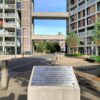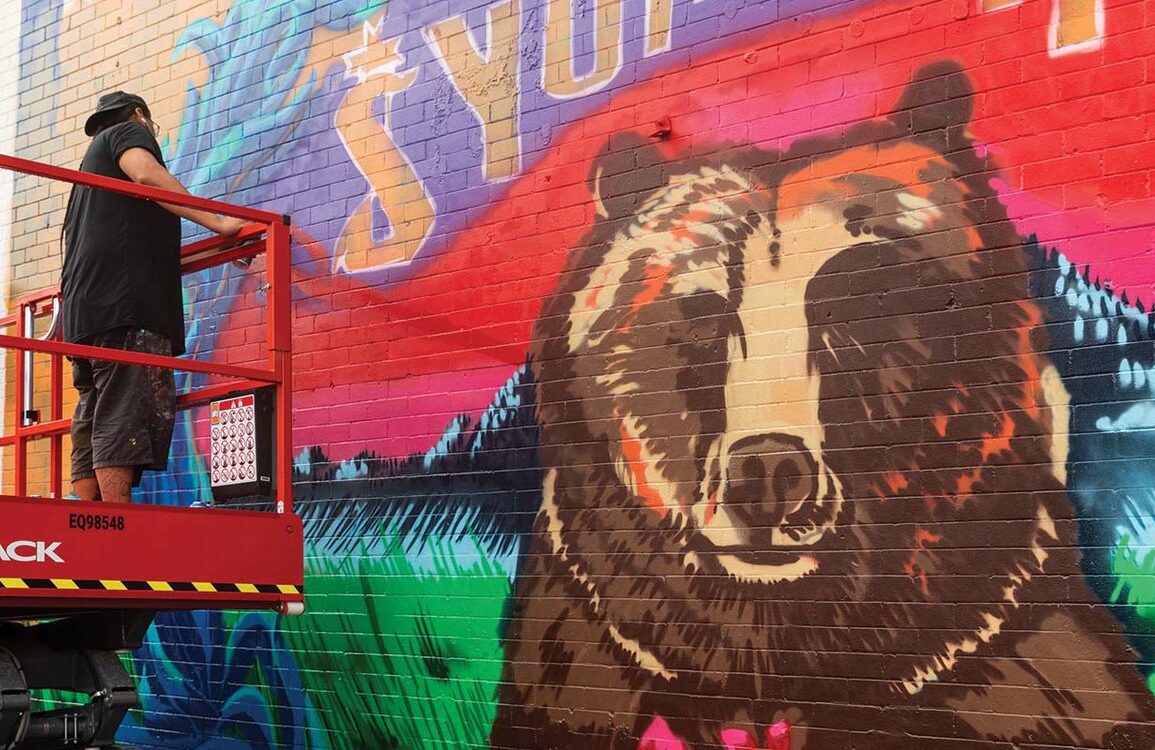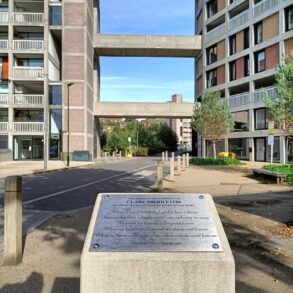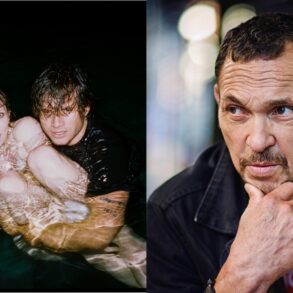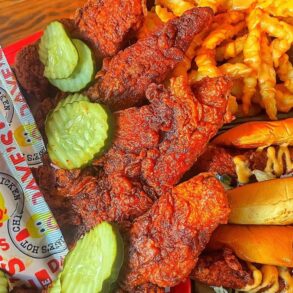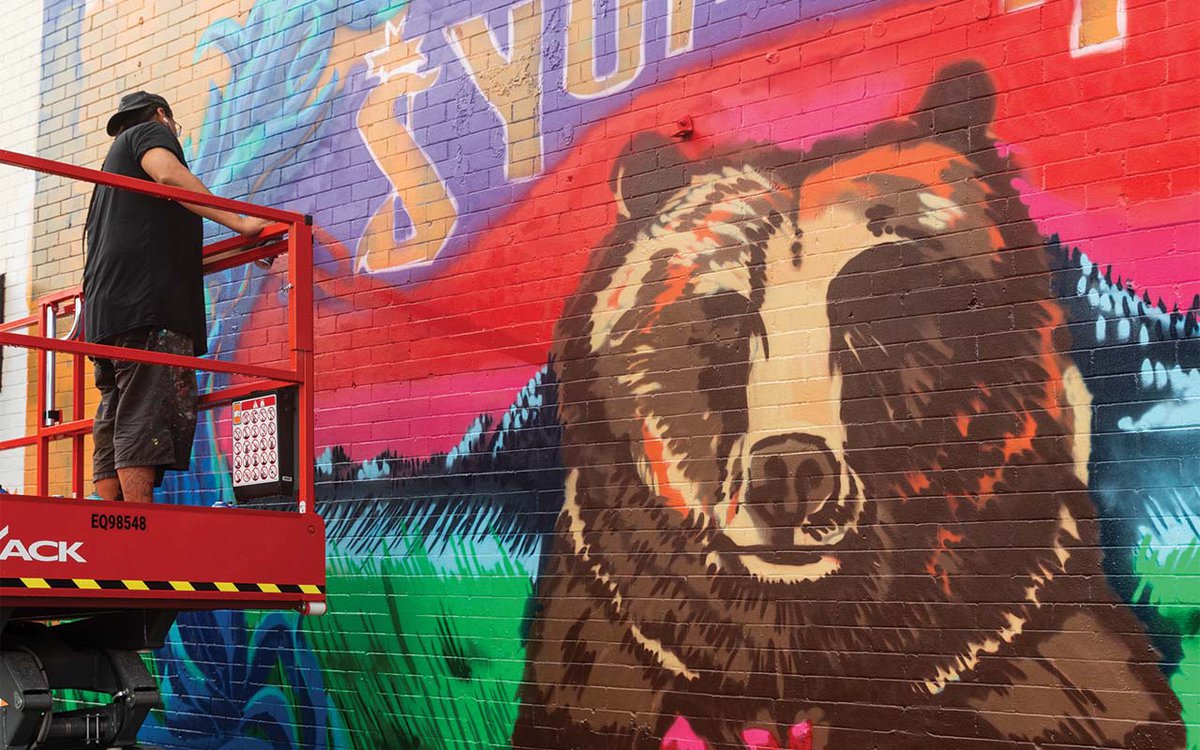
I slip out of my Uptown apartment and into my car, determined to beat the looming summer rain. It’s late July and I’m stopped at a red light at 26th Street and Hennepin Avenue. To my left, I see the side of Sencha Tea Bar freshly painted orange.
When I look closer, however, I can make out the faint traces of what came before it: a fox’s tufted ear; a cluster of flowers. Atop the orange, a new mural buds: the face of a gentle brown bear, its eyes not yet painted; an anatomical heart.
I’ve passed this wall many times—it’s a neighborhood landmark, one that says, “A human has touched this place; you are home.” Seen as catalysts for community building, cultural vibrancy, even economic revitalization, murals and graffiti art seem to have a larger presence in city landscapes than ever.
I meet Esai Luna, creative director of the LynLake Street Art Series, at French Meadow Bakery and Cafe. Every year, the series brings artists to paint new murals in the area during a weekend festival—Luna coordinates with business owners, helps buff out walls, and arranges stipends. He estimates the series has done more than 400 pieces in seven years.
We wander toward The Lynhall, where three mural panels are set in a corner. Two have just been “rotated,” i.e., painted over with new art, as part of the festival.
“The biggest thing to remember is impermanence,” Luna says. “You’re constantly fighting the buff. There’s constant change—there’s the ‘one-up,’ the next level, also the fact that sun causes fade. Businesses change and want different murals.”
This year, the LLSAS expanded to Hennepin Avenue. A budding organization called the Uptown Community Coalition, helmed by Damla Erten and Maren Findlay (both also of Sencha Tea Bar) connected with Luna. The idea to install a mural that would bring a sense of renewal to the block, given Uptown’s post-pandemic tumult, arose, and UCC decided the Sencha building would be the best place.
But there was already a mural on the Sencha building—a luminescent portrait of a fox peering at three fireflies, marveling at their light—painted five years ago by the artist CYFI, AKA Rock Martinez.
Luna asked Martinez if he’d like to paint a new mural over it—Martinez, in turn, reached out to Erten, but the conversation was rocky. He felt the wall was his. Martinez appealed to the building’s owner, who he says was initially supportive, but ultimately, Sencha’s mural wall was assigned to another artist.
I meet Martinez and his wife, fiber artist Brandi Kole, in their St. Paul studio. Martinez tells me he’s been painting that wall, for the most part unpaid, for about 11 years, rotating murals in and out. On April 21, 2016, he was spraying a new piece there when a passerby shouted, “RIP Prince!” out of her car window—it was the first he’d heard of Prince’s passing. He paused his original plans and painted Prince’s purple-hued portrait on the adjacent wall. It rained that day, and a crowd gathered behind him, he remembers.
Martinez says he’d previously signed a contract that essentially gave him the rights to the wall (the building’s owner tells me there was no such contract). He was also traveling to South Dakota during the festival weekend. He has no problem with impermanence, which he sees as inherent to graffiti, but he was deeply upset by how things played out.
“As a graffiti writer and a muralist, we do claim ownership—that was my wall,” he says. “I trusted that somebody would protect me and advocate for me after all these years.”
A related situation recently played out in Northeast when new business owners covered artist Gustavo Lira Garcia’s mural with black paint, causing a small uproar. And no artist is immune. In fact, LLSAS’s own creative director, Luna, says that one of his own murals was recently rolled over orange.
I decide to do my own neighborhood art tour. There’s loads of familiar work: Peyton Scott Russell’s Rise Up mural on Lake Street; a watercolor-like painting of Lake of the Isles; plywood vistas on Hennepin that have remained since the uprisings. Many more appear down alleyways, flashing like leopards in dense jungle underbrush. I see tags on concrete; I see ornate graffiti script that I can’t distinguish as sanctioned or unsanctioned, letters that tether the art to its roots in ’70s-era subcultures in New York and Philly.
I return to the Sencha wall that was once home to Fox and Fireflies, now a kaleidoscopic prairie scene with the Lakota words Canpe iyomahpi, meaning “I have a good heart.” Focus Smith, the artist brought on to paint it, tells me that his art is rooted in Lakota traditions of storytelling, like adorning clothes and painting tepees, and is a reclamation of the colonized visual landscape. His mural is my new neighborhood landmark—for just how long remains to be seen. After all, the building’s owner confirmed to me—he may soon put the property up for sale.
This post was originally published on this site be sure to check out more of their content.

